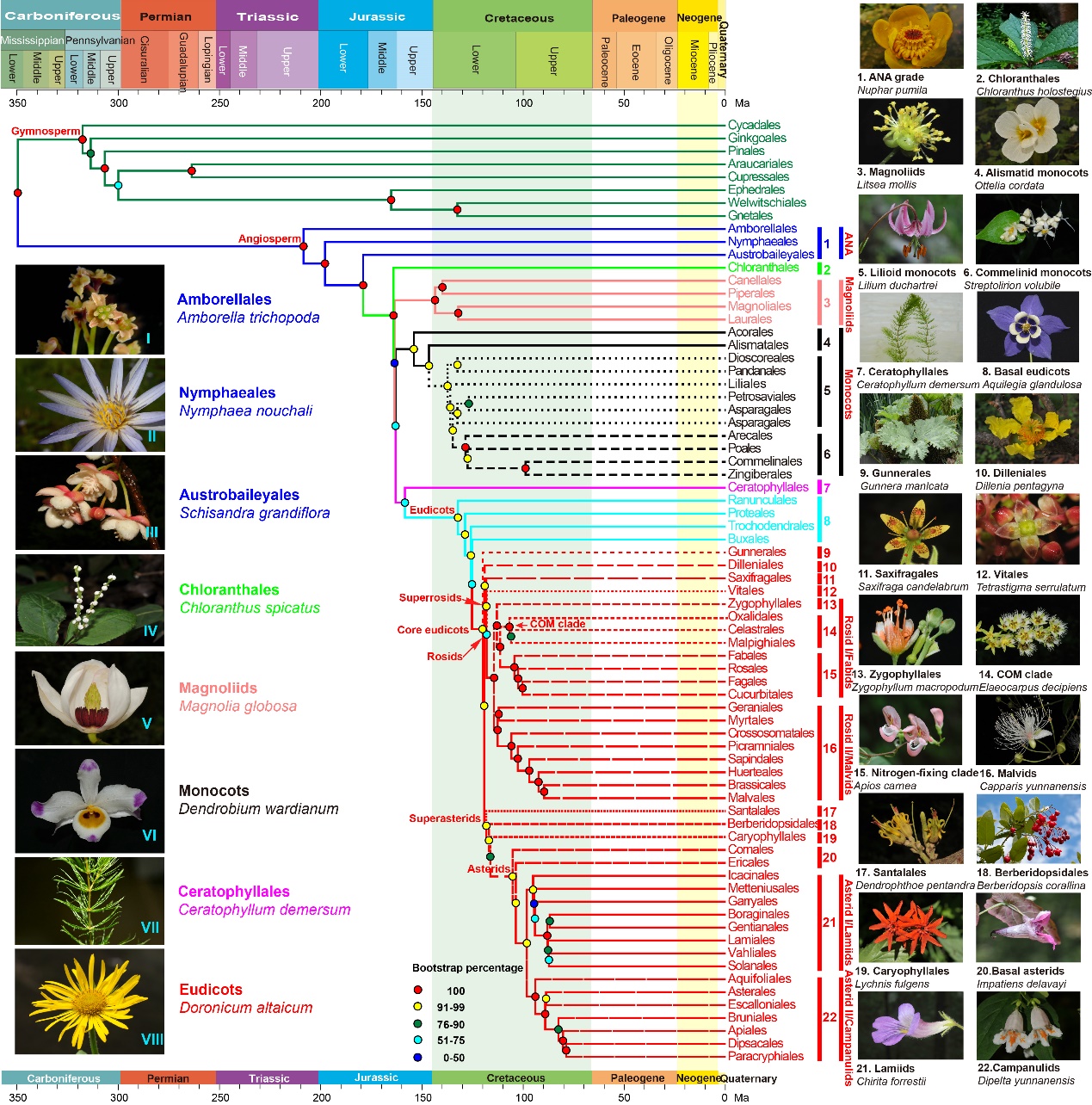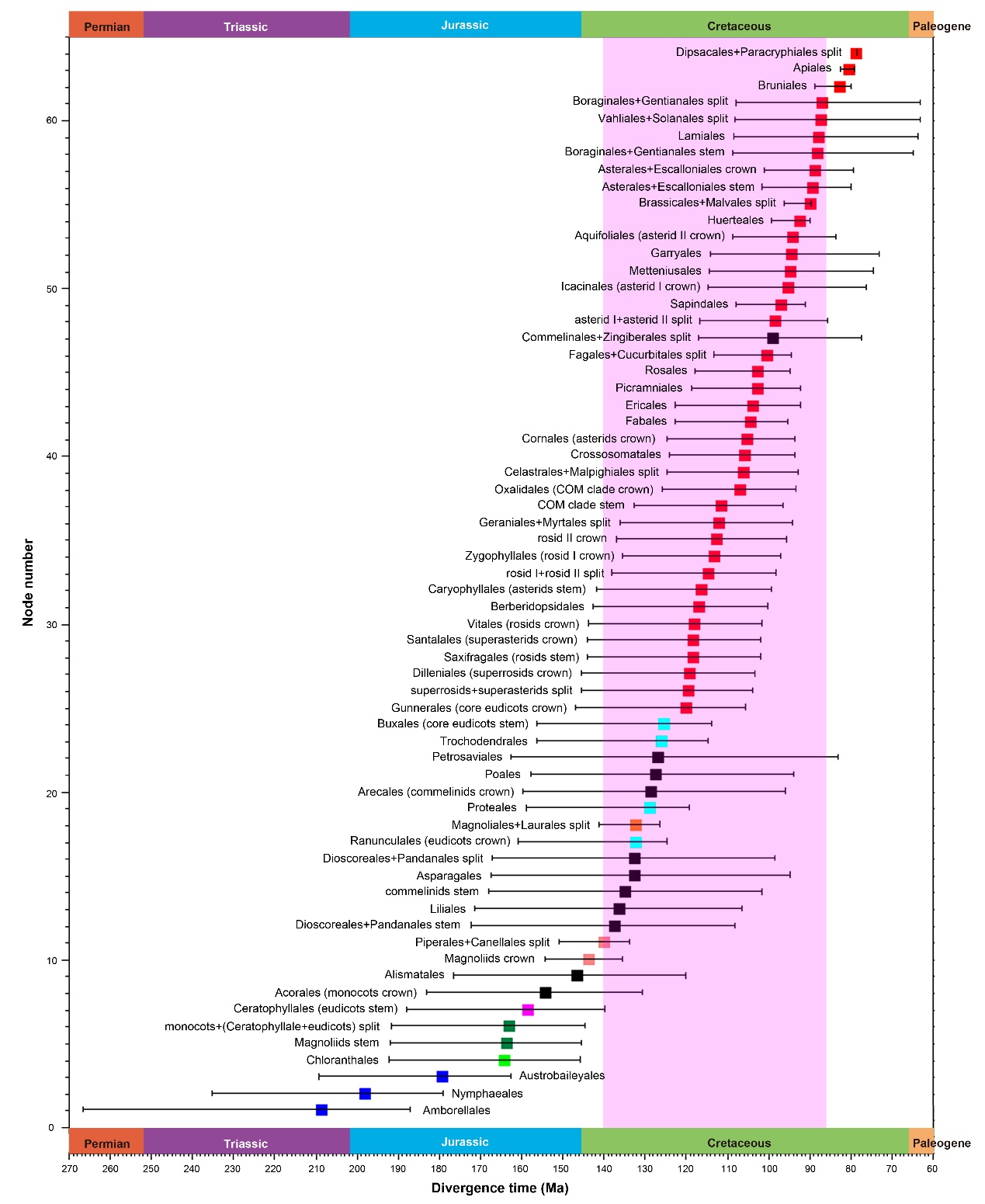Flowering plants (angiosperms) are the most diverse group of plants on Earth with an estimated 295,000 to 370,000 species, exhibiting unmatched morphological, ecological, and functional diversity.
Angiosperms are currently dominating nearly all terrestrial environments, but their origin and early history remain unresolved. The question of origin and early rapid evolution of angiosperms is a crown of the crown in botany. Darwin referred it to as an "abominable mystery" in his correspondence to Sir J. D. Hooker, the then director of the Royal Botanic Gardens Kew in 1879, and the question has been a focus in botany, paleontology and evolutionary biology for 140 years.
Most estimated angiosperm crown ages based on molecular data are in the Jurassic and even the Triassic, which is substantially older than the unequivocal fossils in the Lower Cretaceous. The time of origin of angiosperms is still a puzzle.
A research team led by Professor LI Dezhu from Kunming Institute of Botany, Chinese Academy of sciences (KIB/CAS) has been working on plant phylogenomics for many years.
Facilitated by a national large-scale scientific facility, the Germplasm Bank of Wild Species, the team worked closely international botanists across Asia, North America, Europe, Africa and Oceania on the origin and early diversification of angiosperms.
A large-scale phylogenomic study of angiosperms was carried out with the most extensive familial-level sampling so far.
In this study, 2,694 samples representing 2,351 species and 1,390 genera from all 64 orders and 353 (85%) of the 416 flowering plant families recognized in the classification of the Angiosperm Phylogeny Group (APG IV) were sampled, and 163 species of gymnosperms were used as outgroup taxa.
Data supermatrixes of 80 genes of 2,881 plastid genomes were used to reconstruct a highly resolved and supported plastid phylogenomic angiosperm (PPA) tree. Applying 62 fossil calibrations, the group dated the origin of the crown angiosperms to the Rhaetian in the Upper Triassic (~209 Ma: 267-187 Ma, 95% HPD), which is significantly older than that of unequivocal angiosperm fossils, and the difference was coined for the first time as the "Jurassic gap".
Despite such a large dataset, relationships among the five major clades of core angiosperms, i.e., Chloranthales, magnoliids, monocots, Ceratophyllales and eudicots, were still not fully resolved. It implied that rapid radiation followed by large-scale extinction might have occurred during the early stage of angiosperms. Taking these into account, the team may have a better understanding of Darwin’s abominable mystery by now.
It also revealed that the rise to dominance of angiosperms had gradually replaced gymnosperms in terrestrial ecosystems, which subsequently reshaped the diversification of insects, amphibians, mammals, ferns and many other organisms since the Upper Triassic to Upper Cretaceous.
In 1993, a research group led by Professors Mark Chase, Douglas Soltis and Pamela Soltis who are major collaborators of the current study, comprised of some 40 botanists, reconstructed the first molecular phylogenetic tree of angiosperms using plastid rbcL gene sequences of 499 representative species, which subsequently promoted the birth of the system of classification of APG published in 1998.
Currently, the APG system has dominated and replaced other major systems of classification of angiosperms, and updated to the fourth edition in 2016 (APG IV). In contrast with APG which is based on a summary tree from a large number of published trees, PPA is an explicit tree based on plastid genome supermatrix with comprehensive sampling.
The PPA tree now provided a phylogenetic framework of angiosperms comprising of eight major clades and 22 branches/grades, which will fully update the APG IV system. Compared with APG IV, PPA showed different phylogenetic positions of six orders, resolved the phylogenetic positions of other six orders, and greatly improved supports for three more orders. Compared with the APG website, PPA showed different phylogenetic positions of 41 families, and resolved phylogenetic position of ten more families.
The study was published online entitled "Origin of angiosperms and the puzzle of the Jurassic gap" in Nature Plants.
Drs. Hong-Tao Li, Ting-Shuang Yi, Lian-Ming Gao, Peng-Fei Ma, Ting Zhang and Jun-Bo Yang from KIB, and Dr. Matthew Gitzendanner from University of Florida are the co-first authors, and Professors De-Zhu Li and Soltis Pamela are co-corresponding authors.
This study was funded by the Strategic Priority Research Program of the Chinese Academy of Sciences (CAS) (grant No. XDB31000000), CAS’ Large-scale Scientific Facilities (grant No. 2017-LSF-GBOWS-02), KIB’s iFlora initiative (grant No. 2014-4-11 to D.-Z.L.), the National Natural Science Foundation of China (grant No. 31570333), CAS’ Youth Innovation Promotion Association (grant No. 2015321) and the Ten Thousand Talents Program of China and the Yunling International High-end Experts Program of Yunnan Province.

Fig. 1 Dated phylogenetic tree showing relationships among orders of angiosperms based on a maximum likelihood partitioned analysis of 82,286 bp of DNA sequence from 80 genes of 2,881 plastomes.

Fig. 2 Sorted ordinal and interordinal node age estimates using TreePL based on the phylogenetic trees of 80 genes of 2,881 angiosperm plastomes with maximum likelihood analysis.
Contact:
YANG Mei
General Office
Kunming Institute of Botany, CAS
Email: yangmei@mail.kib.ac.cn
(Editor: YANG Mei)




